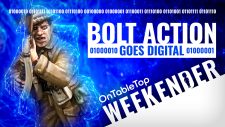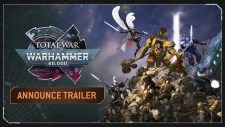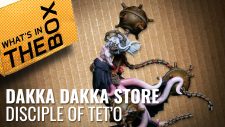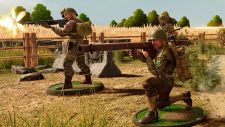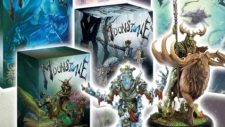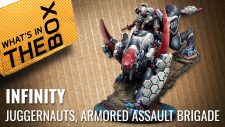Marvel Crisis Protocol Miniatures Game
Review: Bringing the Marvel Universe to your tabletop
Overview :
Marvel Crisis Protocol (MCP) by Atomic Mass Games (AMG) is a skirmish game based on characters from the Marvel universe. The game system itself is fairly rules light and makes use of custom dice to determine success/failure (primary comparing attack dice rolled vs defense dice rolled). Each character has a card that describes their basic stats, attacks, super powers and innate abilities and this is where the depth and color of the game comes from. AMG has done a great job of making each character feel like their super hero (or villain) persona.
Gameplay :
As an overview of gameplay, the game is played in a 3'x3' area by default with around five characters per side. For formal play each player creates a roster that includes 10 characters, a number of Tactics Cards (these are one time use effects) and a number of options for Crisis Cards (these are grouped into take/hold missions and hold the point missions). At the start of a game one of each Crisis type is chosen which defines how victory points are gained and the threat level for the match. The threat level is basically how many points you have available to select team members from your overall roster (ex. Spiderman is a three threat/point model). From there players deploy and play flows back and forth with one player activating a model and then handing off for their opponent to activate a model. This continues until all models have activated and a new round starts. Play continues until one side or the other has reached a set number of victory points or the end of round 6 is reached in which case the player with the most VP wins.
Game play moves quickly and stays engaging thanks to the back and forth activation and reactionary abilities characters have. Almost all character specific rules are contained on their cards which makes it easy to track stats and abilities. A power gaining/spending mechanic is used to fuel abilities and stronger attacks with power gain generally done via weaker "builder" attacks or taking damage (also gained at the beginning of a round). This allows the game to ramp up over time, provides a bounce back method for characters taking damage and gives the player impactful decisions to make.
Terrain is an interesting feature of the game. As far as movement and line of sight effects it's very abstract and simple. Every piece of terrain is given a size (1-5 generally) and depending on how that compares to a characters size it can potentially obstruct movement or grant cover/block line of sight. This makes terrain interactions very understandable but not necessarily intuitive or particularly deep. On the flip side the game does a great job of making terrain part of the action. Many models can throw terrain of specific sizes as part of their super powers, giving them the chance to injure their opponents. This fairly unique concept fits in well with the superhero genre and is a nice part of the game.
Another design choice of the game is that movement and ability ranges are all defined based on the measuring devices that come with the core set. This makes it very easy to play but requires the measuring tools (or knowing the equivalent measurements). Interestingly measuring is not done from point to point as in most miniature games but rather a measuring device only needs to be in touch with a base to be valid (so you generally measure front to back when moving). This means base size matters and each model has an expected base size (as well as a defined size on their card).
In summary the gameplay is easy to pick up, quick to play and fits the theme well. It's a game that deeper in flavor than crunch but still offers enough interactions and decisions to keep more crunch focused players interested.
Materials :
A few materials are part of the game :
Models : The miniatures for this game are plastic and generally sculpted into very dynamic and characterful poses. Detail matches source material well and assembly is fairly easy though some of the more ambitious poses can be trickier. Many have thin bits (swords, effects, etc) but the plastic is fairly flexible and not prone to breakage. Models mostly come in two character boxes that also include their character cards and potentially some mission or crisis cards. I've found that gaps when putting models together are fairly common but generally not too significant. Use of a filler is recommended. Pricing for the box sets is on the high side typically running $15-$20 USD per model (before any retail mark-down) however they do look great and the skirmish nature of the game limits the number of models you "have" to have.
Each pack also includes a number of sculpted bases that fit the size of the models in the set. As a nice feature extra bases are included and there are a number of sculpts so you can mix things up.
Tokens :
Tokens are used to track power, damage, special condition, etc. The core set contains all the tokens you need for a game and expansion sets will include character specific tokens, as well as affiliation and special condition tokens that the included characters or missions need. The tokens are pretty standard good quality paper stock and are rugged enough to survive regular usage.
It should be noted that the Core Box does not include the tokens for special conditions that have been added to the game. These are provided in the character boxes with the models that have abilities that can cause the specific condition.
Measuring devices (4 for abilities, 3 for movement) :
The measuring devices used in the game are specific to MCP and come with the core set. All are plastic with designs sculpted into them that make it worth painting them. No reference to the length of these devices is mentioned in the rule book and it's expected that you have them to play. The devices included in the box are all you'll need though an extra set could be of use.
Terrain :
Terrain is both needed provide cover/LOS blocking/movement impairment but also to allow your characters to throw cars and buildings at each other. AMG includes a number of pieces in the core box and has terrain sets available. Many players make use of toy cars, trucks, etc of an roughly appropriate size. The general concept is that your in a urban environment but there's no restriction around this. As mentioned earlier players should agree on the size of each piece of terrain prior to a game. the AMG terrain is all conveniently labeled with its size. I would say the game expects a moderate level of terrain to be used of varying size.
The AMG terrain has been easy enough to put together and has a nice level of detail.
Crisis Cards :
Crisis Cards define the goals of the mission as well as the mission layout. The core box contains a number of missions as well as the layout cards that the missions will reference (A-F). Additionally some character packs include additional missions. This is both a nice way to expand the game and also a bit of an annoyance as it means you potentially have to buy a set you don't want in order to collect missions. As mentioned earlier, one interesting facet is that you select a set of missions when you create your roster. This let's you choose missions that fit the strengths of your roster. However each game has two missions, one of which will come from each players roster (and the actual mission is selected by the player from a random draw).
The cards themselves are nicely decorated and rugged enough. Many players choose to put them in sleeves but I don't think it's required.
Character Cards :
Character cards are the heart of the game. They provide all the details about a model and it's abilities. Almost all cards are two sided, one for the characters healthy side and the other for their injured side. The layout is easily readable and the card stock is decent enough though feels like it might take a bit of a beating over time. AMG has recently announced they are changing the format of the character cards so we'll see how the new ones look.
Tactics Cards :
Tactics Cards are of the same stock as the Crisis Cards. One side displays comic artwork while the other has the rules for the card. Again a number of these cards are in the core box with more included in most character packs. As with mission packs this is both good and bad as it allows for expansion of the game but can put you in the position of needing to by a model pack in order to get the included crisis cards.
The Core Box is definitely the place to start with this game. It includes terrain, measuring devices, tokens and ten models which is enough to get you up and playing. It also contains a rules booklet but oddly it's not complete. The included rules will get you playing the game but doesn't go into creating rosters, squads or some effects that have been added to the game. These are all available via the living rulebook on the AMG page. While I do like online rules it seems like some of the items left out could have been included in the physical rulebook.
Ruleset :
As I've mentioned a few times above the ruleset is streamlined and quick to pick up. Most of the heavy lifting in flavor and strategy is done via the character cards. The rules are available via the AMG site as is a FAQ, Errata and rule updates. In some cases AMG has chosen to update character cards and they are available online as well. It's nice to see AMG "patching" the system but the expectation that players are following for changes is a bit of a negative. With that said none of these changes are required to have fun playing the game and are more for tournament play and such.
Art :
The artwork for this game fits the theme perfectly. I don't know if the art is taken directly from published comics or if it's created for the game but I think the fact that it's a question demonstrates how well it fits. All the cards are decorated with artwork and character drawings are on both sides of their cards. All the miniatures follow the same art direction and it's easy to recognize your favorite heroes and villains.
Replayability :
As a competitive tabletop game with so many variables the game has a high level of replayability. The simple rules and thematic abilities keep the fun factor high which will make you want to replay the game. AMG has regular releases of new characters (and Tactics Cards, Crisis Cards,etc) which regularly shifts affiliations and provides more list building options.
In addition to "standard" play AMG also puts out Ultimate Encounters which revolve around one player playing an enhanced villain (ex. Thanos, Ultron, Hulk, etc) and two other players taking teams to try and defeat them. These make for a nice shift in game play and also allow for three players to take part at once.
Final Word :
MCP is a game that does so much to bring the theme of comic book superheroes (and villains) to the table top. I find it to be a fun game with a good challenge level and would recommend it to anyone who enjoys the genre.





























